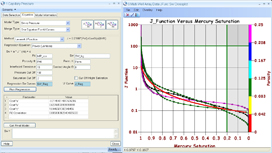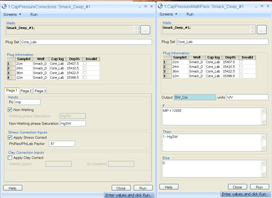CAPILLARY PRESSURE
Determining the relative water saturations and height above free water is a critical step in understanding the subsurface and defining an efficient drilling program. With this understanding, reservoir engineers can avoid drilling into free water, determine compartmentalization and identify zones that are in communication.
Determine Height Above Free Water
Using Capillary Pressure, geoscientists evaluate well logs and cores from multiple wells and zones to model saturation versus height above free water level (FWL). The resulting analytical expressions relate either connate water saturation to height above FWL (forward modeling) or height above FWL to connate water saturation (reverse modeling). Findings from one well can be applied to other wells in the area, making the process efficient and consistent.
Capillary Pressure, an add-on modules to PowerLog®, enables users to evaluate core plugs, create groups of plugs with similar J-Functions, compute pore throat distributions and view associated pore throat histograms.
Capillary Pressure Workflow
A normal capillary pressure workflow is:
- Import core data
- Verify/modify lab measurement parameters
- Correct data sets for stress, clay, closure and normalization
- QC data
- Categorize the data sets
- Apply a fitting function
- QC results
- Output the fitted functions
Geoscientists can then determine FWL and saturation versus height profiles in zones and wells.
Interactive Data Loader
To facilitate fast and easy import of data, Capillary Pressure features an elegant data loader that quickly assesses input files and identifies columns and sheets of data for import. Data is loaded from ASCII and Excel files and can be in array format. Pressure data is handled in their original units, and saturation is automatically computed from fluid volumes as needed. When more than one saturation value is available for a single fluid type in the data set, the user can set the desired level.























